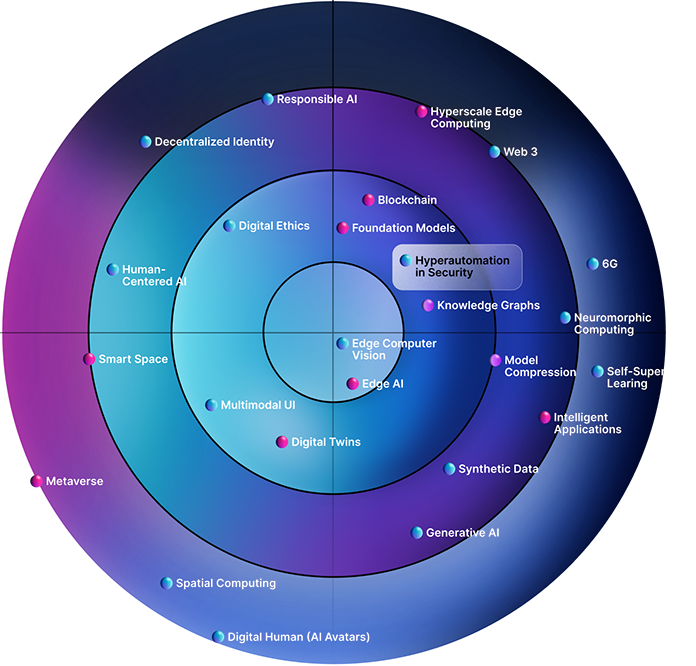Introduction to Hyperautomation in Security
Hyperautomation in security represents a transformative shift in how organizations handle cyber threats and vulnerabilities. By integrating technologies such as artificial intelligence (AI), machine learning, robotic process automation (RPA), and security orchestration, automation, and response (SOAR), hyperautomation streamlines and enhances the entire security lifecycle. This powerful combination enables enterprises to detect, analyze, respond to, and recover from cyber threats with greater speed, accuracy, and efficiency. In a digital environment where attacks are becoming more sophisticated and frequent, hyperautomation is emerging as a critical tool in modern security strategies.
The Core Components of Hyperautomation
Hyperautomation is more than just automation—it is an intelligent, evolving system that learns and adapts. It starts with RPA handling repetitive and rule-based tasks, then integrates AI and machine learning to bring context-aware decision-making into the mix. In the realm of cybersecurity, this means automatically correlating threat data, prioritizing incidents, and even initiating countermeasures without human intervention. Security operations centers (SOCs) can benefit immensely by minimizing manual work and reducing alert fatigue. Hyperautomation supports an end-to-end approach that spans data gathering, event correlation, threat intelligence analysis, and real-time response.
Enhancing Threat Detection and Response
Traditional security systems often struggle to keep pace with today’s fast-evolving threat landscape. Hyperautomation addresses this gap by leveraging AI-driven tools that identify unusual patterns and potential threats across a network with precision. Automated threat detection uses behavioral analytics and anomaly detection to flag suspicious activities early, significantly reducing the time to detection. Moreover, once a threat is identified, automated response workflows can isolate affected systems, block malicious IPs, or initiate predefined containment procedures—thus drastically shortening the time to respond and mitigating potential damage.
Streamlining Security Operations
Security teams frequently face the challenge of handling thousands of alerts daily, many of which turn out to be false positives. Hyperautomation helps by automating triage processes, allowing security analysts to focus only on high-priority incidents. With intelligent automation, security operations are optimized through playbooks and workflows that guide responses based on the nature and severity of the threat. This streamlined process improves incident management and ensures a consistent, error-free response to known issues. It also reduces human error and increases the overall reliability of the security system.
Real-Time Decision Making with AI and ML
One of the defining features of hyperautomation is its ability to enable real-time decision-making. Machine learning algorithms continuously learn from historical data and user behavior to enhance their threat detection capabilities. These systems evolve with time, becoming more effective at predicting potential threats before they occur. AI tools can prioritize alerts based on risk level, suggest recommended actions, and even automate decision-making processes under certain conditions. This real-time intelligence empowers organizations to stay one step ahead of cyber attackers.
Integration with Existing Security Tools
Hyperautomation doesn't require organizations to start from scratch. Instead, it integrates seamlessly with existing security infrastructure such as firewalls, intrusion detection systems (IDS), endpoint detection and response (EDR) tools, and SIEM platforms. Through APIs and connectors, hyperautomation solutions can aggregate data from multiple sources, unify security processes, and enable orchestrated response actions across tools. This cohesive ecosystem not only increases visibility but also improves the coordination and efficiency of security teams.
Benefits of Hyperautomation in Cybersecurity
The benefits of hyperautomation in security are extensive. First and foremost, it improves operational efficiency by reducing the need for manual intervention. It also enhances detection accuracy and speeds up response times, which are critical in minimizing damage from cyber incidents. Additionally, hyperautomation supports scalability—allowing security operations to expand as the organization grows without proportionally increasing human resources. Cost savings, reduced downtime, improved compliance, and better risk management are other significant advantages that make hyperautomation a worthwhile investment.
Overcoming Implementation Challenges
Despite its benefits, implementing hyperautomation in security requires careful planning and execution. Organizations may face challenges such as tool compatibility, data privacy concerns, and a shortage of skilled professionals. Success lies in choosing the right use cases for automation, ensuring seamless integration with current systems, and providing adequate training to staff. Collaboration between IT and security teams, along with strong leadership support, is essential to driving adoption. It’s also crucial to maintain transparency in automated processes to build trust and accountability.
The Future of Security with Hyperautomation
As cyber threats become increasingly complex and persistent, hyperautomation will play a pivotal role in future-proofing cybersecurity strategies. Its ability to provide intelligent, adaptive, and autonomous defense mechanisms is reshaping the way organizations protect their digital assets. With continuous advancements in AI, machine learning, and orchestration technologies, hyperautomation will evolve to address emerging threats in real-time. By enabling faster responses, better decision-making, and more efficient resource utilization, it stands as a cornerstone of next-generation security infrastructure.
Read More - https://www.marketresearchfuture.com/reports/hyperautomation-in-security-market-12227
Conclusion
Hyperautomation in security is more than a trend—it's a critical evolution in cybersecurity. By fusing AI, machine learning, and automated workflows, it empowers organizations to detect, respond to, and recover from threats with unmatched speed and precision. As cyber risks escalate, hyperautomation offers a proactive and resilient defense framework that enhances security outcomes while optimizing operations. Embracing this intelligent automation approach is essential for any organization looking to stay ahead in today’s rapidly evolving digital world.



